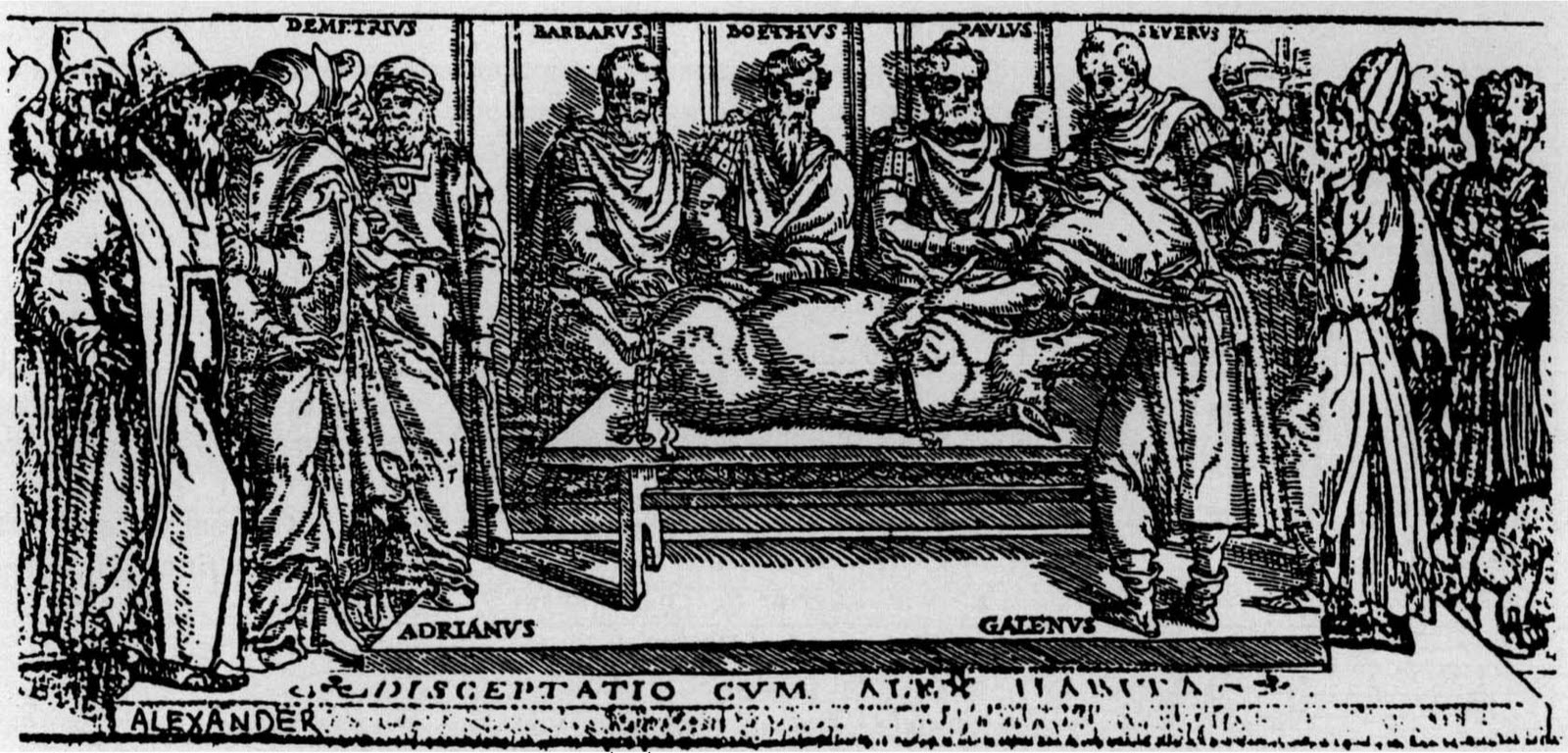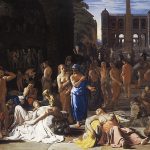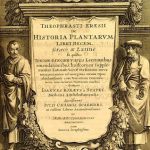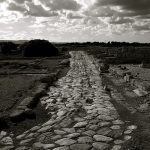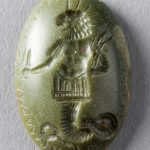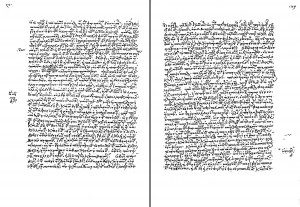
A medical manuscript of the 14th c (Urbinas gr. 67)
For the general public, the idea of medieval manuscripts may raise the image of beautifully calligraphed, usually ornate, old parchment books with heavy (even jewel-incrusted at times) bindings. The many Twitter accounts run by medievalists posting daily several wonderful pictures of illuminations and marginal drawings and paintings can only support such a common view. At a recent (and remarkable) exhibition in Durham devoted to the Lindisfarne Gospels, manymanuscripts were on display – but the richly decorated Gospel that drew thousands of visitors to the Cathedral close, was meant to steal the show. Indeed, the exhibition was designed to demonstrate the exceptional value of this (indeed impressive) book.
For me, the real star of the Lindisfarne Gospel exhibition was another manuscript: the St Cuthbert Gospel (BL add. 89,000), a tiny, modest book with a simple leather binding containing Saint John’s gospel. From a historical and codicological point of view, it is a most remarkable artefact. Allegedly found in Cuthbert’s coffin in 1104 among other precious relics, the book is thought to have been made at Wearmouth-Jarrow shortly before 700, and to ‘have been the very copy that SS. Cuthbert and Boisil had read together at Melrose when the latter was on his deathbed’ (R. Gameson, 2013). It is indeed the earliest surviving intact European book. Its original binding is, in itself, a most precious object. However, I was less interested in the historical interest of the book, or in its relative sanctity as a book that belonged to Cuthbert himself, than I was moved by the object as a personal possession of a long-dead person. Regardless of Cuthbert’s character, to be able to see what must have been one of his dearest and most intimate possessions felt really special. The fact that it is so well preserved adds, of course, to its evocative power. In his religious, secluded life, Cuthbert must have cherished this holy book like no other. This is probably why it was included in his coffin, and placed next to his face.
Somehow, it reminds me of my first manuscripts. The manuscripts I first handled, carried, opened, turned around and examined, in the hope of finding clues towards their interpretation as cultural objects. Although I am not technically a specialist of manuscripts, I get to see a lot of them. I have probably used over a hundred of them, maybe two hundreds. It would be little for a professional curator, it is a lot for a classicist. Moreover, I have dealt almost exclusively with medical manuscripts, or miscellaneous with a certain amount of medical pages, from the 10th to the 17th century. What the majority of those manuscripts have in common, is that they have been little studied, or not at all. Classified as technical, often deprived of any significant element of decoration, bound in unoriginal bindings, they got buried in the depths of European collections. Rarely do they make it to an exhibition display! Yet there is a special emotion the first time you see a manuscript, however ugly it is. The first manuscript ever, of course, sends a unique shrill down the spine; the weight, the stiffness, the solemn look on the librarian’s face, everything contributes to make a lasting impression; but every additional manuscript, however grey and boring on the surface, will procure a bit of excitement. One of the first I ever handled, at the time of my PhD, was a thick Byzantine collection of medical works (Parisin. gr. 2270), with its original binding, written on paper and dated to the 14th c. It turned out to be a relatively important link in the history of the text I was studying (Ps. Galen’s Introductio sive medicus), as it was used to make several additional copies in the following century. Indeed, as demonstrated by Brigitte Mondrain, the manuscript was for a while in the hands of a scholar, Demetrios Angelos, who restored it in the damaged sections. He also created or supervised further copies of the texts preserved in the thick, worn out book. Demetrios played a major role in the preservation of Galen’s works for the future: he made many copies himself, he restored older ones that were falling apart, he scribbled a few notes and added some dodgy diagrams. He worked with colleagues who helped in his task, probably assigned by a more famous scholar, John Argyropoulos. But unlike the internationally renowned professor, who left Constantinople, Demetrios stayed, until well after the city was captured by the Ottomans. Without him, we would have lost a fair amount of Galenic material. But his terrible handwriting doesn’t serve his modern scholarly readers. The purpose of such copies was often private study. Indeed, educated Byzantines needed collections of texts in a readily accessible format, in order to travel with them (this was before Kindle, but pocket-format books did exist) and use them at leisure. Due to the costs of making manuscripts, those practical books are more often on paper than parchment, and usually crammed with inelegant script. There is no space for illustrations or even for comfortable margins. Annotations are so tiny or hasty that they become almost illegible. Such were the books used by physicians, philosophers, astronomers and the like. Scribes and scholars of Byzantium sometimes had fine copies made for the sake of preservation – but they almost never bothered with producing a really beautiful manuscript. Exceptions do exist (such as the splendid ms. of Vienna, 1 of the 6th c. and the 10th c. Laurentianus 74, 7). But they really are exceptions!
To me, opening those personal collections of apparently random texts (extracts, quotations, letters, mixed with entire treatises on a specialised matter) will always be special. I may not know much about each of those books, because they have been damaged or left unstudied for centuries and the memory of their original possessor is lost. Sometimes I also lack the knowledge to analyse them correctly and I have to do a lot of research to achieve some result. They are nevertheless all we have to reach our goal, which is to produce a sound reconstruction of an ancient text. As such, they are extremely precious. But beyond helping me reconstruct ancient medical texts, those ‘ugly manuscripts’ also witness to a long gone lifestyle and somehow keep a little something of the personal, intimate feel they once had.

A tiny Byzantine pocket collection of miscellaneous texts (Oxf. Clarke 16)

Two pages of the same diminutive collection.

The leather binding of the ‘Cuthbert’s gospel’ (BL Add. 89,000)

St Cuthbert Gospel, BL Add. 89,000, 7th c. AD

A typical page from a medical/astrological collection (Florence)
Additional reading:
R. Gameson, From Holy Land to Durham: The Contexts and Meanings of the Lindisfarne Gospels, London, 2013
L. D. Reynolds/N. Wilson, Scribes and Scholars of Byzantium: A guide to the transmission of Greek and Latin Literature, Oxford University Press, 1968 (several re-editions)
